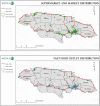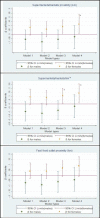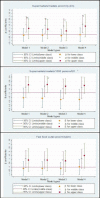Understanding neighbourhood retail food environmental mechanisms influencing BMI in the Caribbean: a multilevel analysis from the Jamaica Health and Lifestyle Survey: a cross-sectional study
- PMID: 32830113
- PMCID: PMC7445353
- DOI: 10.1136/bmjopen-2019-033839
Understanding neighbourhood retail food environmental mechanisms influencing BMI in the Caribbean: a multilevel analysis from the Jamaica Health and Lifestyle Survey: a cross-sectional study
Abstract
Objective: To derive estimates of the associations between measures of the retail food environments and mean body mass index (BMI) in Jamaica, a middle-income country with increasing prevalence of obesity.
Design: Cross-sectional study.
Setting: Data from the Jamaica Health and Lifestyle Survey 2008 (JHLS II), a nationally representative population-based survey that recruited persons at their homes over a 4-month period from all 14 parishes and 113 neighbourhoods defined as enumeration districts.
Participants: A subsample of 2529 participants aged 18-74 years from the JHLS II who completed interviewer-administered surveys, provided anthropometric measurements and whose addresses were geocoded.
Primary outcome measure: Mean BMI, calculated as weight divided by height squared (kg/m2).
Results: There was significant clustering across neighbourhoods for mean BMI (intraclass correlation coefficients=4.16%). Fully adjusted models revealed higher mean BMI among women, with further distance away from supermarkets (β=0.12; 95% CI 8.20×10-3, 0.24; p=0.036) and the absence of supermarkets within a 1 km buffer zone (β=1.36; 95% CI 0.20 to 2.52; p=0.022). A 10 km increase in the distance from a supermarket was associated with a 1.7 kg/m2 higher mean BMI (95% CI 0.03 to 0.32; p=0.020) in the middle class. No associations were detected with fast-food outlets or interaction by urbanicity.
Conclusions: Higher mean BMI in Jamaicans may be partially explained by the presence of supermarkets and markets and differ by sex and social class. National efforts to curtail obesity in middle-income countries should consider interventions focused at the neighbourhood level that target the location and density of supermarkets and markets and consider sex and social class-specific factors that may be influencing the associations.
Keywords: diabetes & endocrinology; epidemiology; nutrition & dietetics; public health.
© Author(s) (or their employer(s)) 2020. Re-use permitted under CC BY-NC. No commercial re-use. See rights and permissions. Published by BMJ.
Conflict of interest statement
Competing interests: None declared.
Figures



Similar articles
-
Neighbourhood characteristics and cumulative biological risk: evidence from the Jamaica Health and Lifestyle Survey 2008: a cross-sectional study.BMJ Open. 2018 Dec 14;8(12):e021952. doi: 10.1136/bmjopen-2018-021952. BMJ Open. 2018. PMID: 30552247 Free PMC article.
-
Associations of neighborhood physical and crime environments with obesity-related outcomes in Jamaica.PLoS One. 2021 Apr 5;16(4):e0249619. doi: 10.1371/journal.pone.0249619. eCollection 2021. PLoS One. 2021. PMID: 33819299 Free PMC article.
-
Associations between major chain fast-food outlet availability and change in body mass index: a longitudinal observational study of women from Victoria, Australia.BMJ Open. 2017 Oct 16;7(10):e016594. doi: 10.1136/bmjopen-2017-016594. BMJ Open. 2017. PMID: 29042381 Free PMC article.
-
Associations between supermarket availability and body size in Australia: a cross-sectional observational study comparing state and territory capital cities.BMC Public Health. 2021 Feb 25;21(1):407. doi: 10.1186/s12889-021-10458-9. BMC Public Health. 2021. PMID: 33632182 Free PMC article.
-
Obesity: diagnosis and prescription for action in the English-speaking Caribbean.Rev Panam Salud Publica. 2003 May;13(5):336-40. doi: 10.1590/s1020-49892003000400013. Rev Panam Salud Publica. 2003. PMID: 12831439 Review. No abstract available.
Cited by
-
Social support and ideal cardiovascular health in urban Jamaica: A cross-sectional study.PLOS Glob Public Health. 2024 Jul 30;4(7):e0003466. doi: 10.1371/journal.pgph.0003466. eCollection 2024. PLOS Glob Public Health. 2024. PMID: 39078827 Free PMC article.
-
The rural food environment and its association with diet, nutrition status, and health outcomes in low-income and middle-income countries (LMICs): a systematic review.BMC Public Health. 2025 Mar 13;25(1):994. doi: 10.1186/s12889-025-22098-4. BMC Public Health. 2025. PMID: 40082817 Free PMC article.
-
Identifying obesogenic environment through spatial clustering of body mass index among adults.Int J Health Geogr. 2024 Jun 26;23(1):16. doi: 10.1186/s12942-024-00376-5. Int J Health Geogr. 2024. PMID: 38926856 Free PMC article.
-
Perceptions of the local food environment and fruit and vegetable intake in the Eastern Caribbean Health Outcomes research Network (ECHORN) Cohort study.Prev Med Rep. 2022 Feb 2;26:101694. doi: 10.1016/j.pmedr.2022.101694. eCollection 2022 Apr. Prev Med Rep. 2022. PMID: 35242499 Free PMC article.
-
The influence of the urban food environment on diet, nutrition and health outcomes in low-income and middle-income countries: a systematic review.BMJ Glob Health. 2021 Oct;6(10):e006358. doi: 10.1136/bmjgh-2021-006358. BMJ Glob Health. 2021. PMID: 34635553 Free PMC article.
References
-
- Caribbean Commission on Health and Development Report of the Caribbean Commission on health and development PGs 37-42: Ian Randle publishers, 2006. Available: http://www.who.int/macrohealth/action/PAHO_Report.pdf?ua=1 [Accessed 28 Nov 2014].
-
- Henry FJ. Obesity prevention: the key to non-communicable disease control. West Indian Med J 2011;60:446–51. - PubMed
-
- Wilks R, Younger N, Tulloch-Reid M, et al. . Jamaica Health and Lifestyle Survey 2007-8, 2008. Available: http://www.mona.uwi.edu/reports/health/jhlsii_final_may09.pdf [Accessed 1 Feb 2015].
-
- Ashcroft MT, Ling J, Lovell HG, et al. . Heights and weights of adults in rural and urban areas of Jamaica. Journal of Epidemiology & Community Health 1966;20:22–6. 10.1136/jech.20.1.22 - DOI
-
- Rotimi CN, Cooper RS, Ataman SL, et al. . Distribution of anthropometric variables and the prevalence of obesity in populations of West African origin: the International collaborative study on hypertension in blacks (ICSHIB). Obes Res 1995;3 Suppl 2:95s–105. 10.1002/j.1550-8528.1995.tb00452.x - DOI - PubMed
MeSH terms
LinkOut - more resources
Full Text Sources
